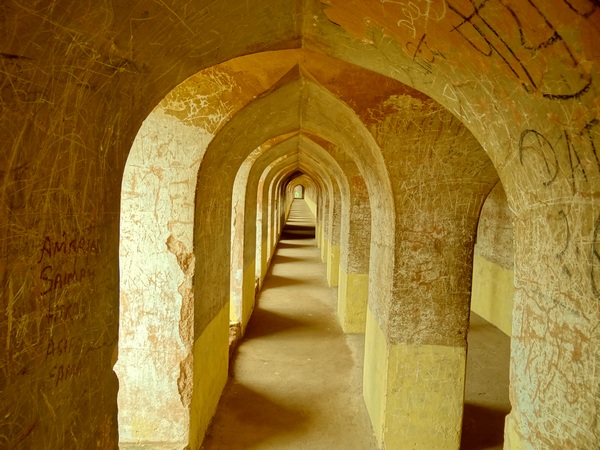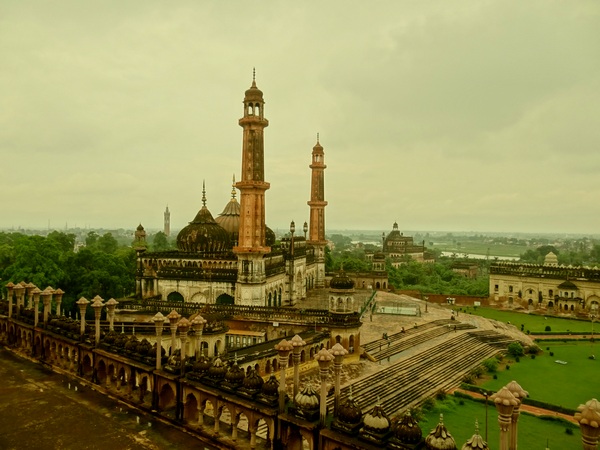Photographs: Nirdesh K Singh Nirdesh K Singh
Nirdesh K Singh who has been fort-hopping (read this and this) visited the Bada Imambara of Lucknow and returned with this story!
Nawabs have taken a lot of bad rap in the press for being fat, drunk and kowtowing to the British. But here is a story that will warm the cockles of your cynic heart.
To be fair to the press, Asaf-ud-Daula, Nawab of Awadh also started as fat, drunk and gifting away territories to British.
Asaf-ud-Daula was the forth Nawab Wazir of Awadh. During his reign, Lucknow acquired majestic status and there was the emergence of Shia culture that was in constant interaction with Shia lands of Iran and Iran resulting in Lucknow becoming a great knowledge centre. It is said that the luxury of Awadh rivalled that of Nizam's Hyderabad.
According to historians, Asaf-ud-Daula used to laugh with no apparent reason, would abuse others and expected to be abused in return. We are aware of other interests of Nawabs but this is novel!
He had immense respect for people who used filthy language and the more the obscene language the more he was pleased. He was juvenile, unambitious and would drink with his servants.
Now this is a glowing example where class consciousness disappears and the bourgeoisie and the proletariats become one -- another side effect of liquor. The only thing his father could get him to do was to learn archery!
The amazing story of Lucknow's Bada Imambara
Image: The grand entrance to Bada ImambaraPhotographs: Nirdesh K Singh
Asaf-ud-Daula however had another unbeatable attribute -- generosity. It is said that even today shopkeepers in Lucknow open their shops with his name on their lips. Of the many tales of his generosity, the biggest one is as follows.
The story goes that Awadh was hit by a severe famine in 1783. There was general starvation in the Awadh area.
So instead of saying that people who do not have rotis to eat, let them eat tunde kebabs, he started the construction of Bada Imambara.
Not just the commoners, but the nobility which was feeling the heat of the famine also participated.
This was something similar to our present day Mahatma Gandhi National Rural Employment Guarantee Act (NREGA). Who knows, perhaps Keynes and Jacques Dreze got ideas from the Nawab on generating employment!
The amazing story of Lucknow's Bada Imambara
Image: Central Vaulted Chamber with Nawab's GraveThe famine lasted for a decade. To continue to generate employment, the construction also continued for the period the famine lasted.
It is said that the commoners would erect the walls during the day. On the fourth night, the nobility would dismantle whatever was constructed. For their efforts, the nobility also received payments.
This ensured that work lasted and people did not starve. About 20,000 people found employment in this noble project!
Despite the continuous building and breaking, the Bada Imambara turned out to be a magnificent building. It rivalled the Moghul architecture. No iron or cement has been used in the building.
The Imambara boasts of one of the largest arched structure with no supporting beams.
Under this vaulted chamber, lies the simple grave of the Nawab. The grave of the architect also lies in the main hall.
The amazing story of Lucknow's Bada Imambara
Image: Try not getting lost in the BhoolbhulaiyaPhotographs: Nirdesh K Singh
If you are feeling adventurous, then go into the bhulbhulaiyaa (labyrinth) on top of the main hall with a guide. The bhulbhulaiya has 489 identical doorways and is possibly India's only maze.
On one side of the Imambara is the baoli. Though the baoli is at a 45 degrees angle to the main gate, you can see the reflection of the main street in the baoli water.
You could not figure out the optical illusion or miracle. According to the guide, the reflection carries clear colours so that the guards inside could see the red uniforms of British soldiers at the main gate. It's just like a CCTV watching your front gate.
The amazing story of Lucknow's Bada Imambara
Image: Asfi MosquePhotographs: Nirdesh K Singh
The other side of the Imambara has the Asfi mosqe with towering minars that was also built as part of the relief measures. Like what I have heard at Jhansi and Mandu, there is an apocryphal story about a tunnel here too which goes all the way to Delhi and Allahabad.
Just outside the main gate is the equally impressive Rumi Darwaza. The local municipal corporation ensures that you cannot get a single clear shot of the gate because of the strategically placed electric poles with avant garde posters, banners of local politicians and hanging cables.
What made the Nawab turn charitable and generous is unknown. There was a saying that if one did not receive from God, he would receive from Asaf-ud-Daula. Which by all accounts doesn't seem too far fetched!
Getting there: Bada Imambara is in the heart of the city. Along with Bada Imambada, go see the British Residency.






Comment
article